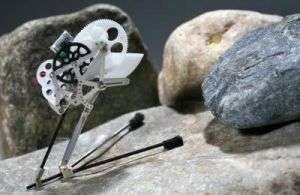Mechanical locomotion principles from jumping insects applied to microrobots

Researchers from the Laboratory of Intelligent Systems at EPFL are unveiling a novel, grasshopper-inspired jumping robot at the IEEE International Conference on Robotics and Automation May 21 in Pasadena, California.
The robot weighs a miniscule 7 grams, and can jump 1.4 meters, or more than 27 times its body size -- ten times farther for its size and weight than any existing jumping robot.
These jumpers could be fitted out with tiny sensors to explore rough, inaccessible terrain or to aid in search and rescue operations.
"This biomimetic form of jumping is unique because it allows micro-robots to travel over many types of rough terrain where no other walking or wheeled robot could go," explains EPFL Professor Dario Floreano. "These tiny jumping robots could be fitted with solar cells to recharge between jumps and deployed in swarms for extended exploration of remote areas on Earth or on other planets."
Small jumping animals such as fleas, locusts, grasshoppers and frogs use elastic storage mechanisms to slowly charge and quickly release their jumping energy. In this way, they can achieve very powerful jumps and very high accelerations. The jumping robot presented here uses the exact same principle, charging two torsion springs via a small 0.6-gram pager motor and a cam.
In order to be able to optimize the jumping performance, the legs can be adjusted for jumping force, takeoff angle and force profile during the acceleration phase. The tiny battery on board allows it to make up to 320 jumps at intervals of 3 seconds.
This work will be presented by Mirko Kovac May 21 in Pasadena, California during the ICRA's "Dynamic Walking" Session."
Source: Ecole Polytechnique Fédérale de Lausanne





















